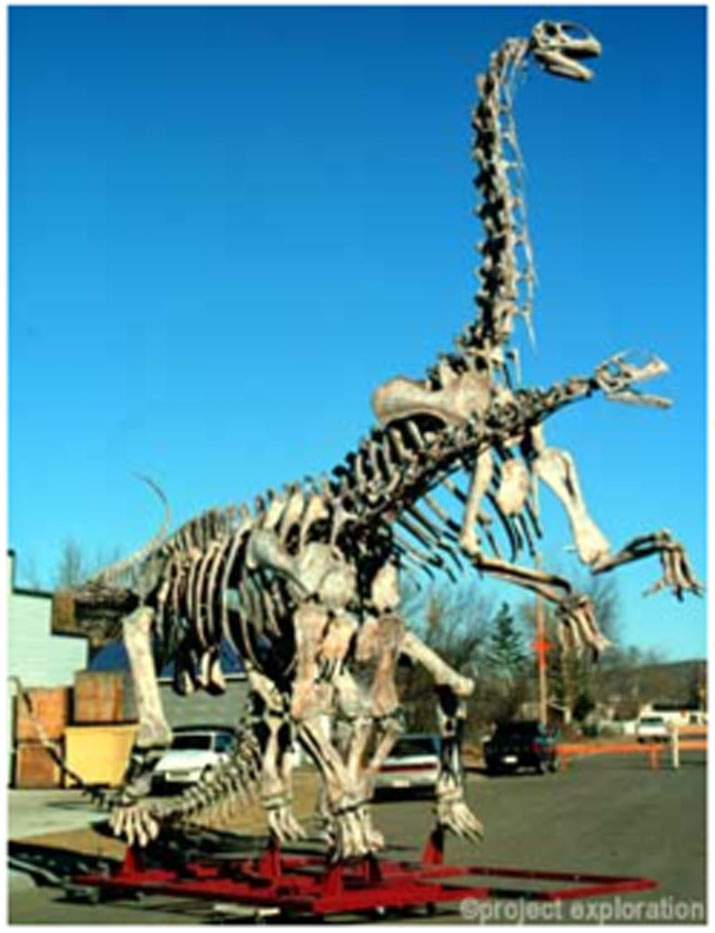Paul Sereno’s Press Release
Two Skeletons of Gigantic Plant-eating dinosaur unveiled
A primitive, long-necked dinosaur that weighed an estimated 40,000 pounds and grew to a length of 70 feet is the newest species to be plucked from the African Sahara by a team led by University of Chicago paleontologist Paul Sereno.
With 95 percent of its skeleton preserved, the new species stands as the most complete long-necked dinosaur ever discovered from teh Cretaceous Period,” Sereno said.
The species, discovered in the Republic of Niger and described in the Nov. 12 issue of the journal Science, was unveiled Thursday, November 11 at a news conference at the National Geographic Society, a sponsor of the project.
Toiling in temperatures exceeding 120 degrees, Sereno’s team excavated tons of bone and rock during a 1997 expedition and spent that last two years cleaning and studying the bones. Sereno’s team has constructed two cast skeletons: an adult, rearing to a height of more than 30 feet, and a juvenile, posed in mid-stride.
The new dinosaur, named Jobaria tiguidensis , lived about 135 million years ago in the Cretaceous Period when open forests and broad rivers characterized the region. Jobaria (JO-BAR-E-YA) refers to “Jobar,” a creature in the legends of the local nomadic Tuareg people, to whom they had attributed the exposed bones; tiguidensis (TI-GI-DEN-SIS) refers to the cliff near the excavation sites.
The main graveyard site contained bones of several adults and juvenile individuals, suggesting that Jobaria once roamed in herds of mixed age, Sereno said. Although an ancient flash flood quickly buried the animals, some may have died at the hands of the chief meat-eating dinosaur of the time, Afrovenator , a 27 foot-long predator previously discovered in the same area by Sereno’s team. Tooth marks are present on the ribs of one of the juvenile skeletons.
Jobaria doesn’t fit into any recognized family of long-necked dinosaurs, or sauropods. Rather, Jobaria represents an ancient sauropod lineage that survived and flourished only in Africa during the Cretaceous. Unlike other Cretaceous sauropods, Jobaria has spoon- shaped teeth and a relatively short neck composed of only 12 vertebrae. Jobaria’s backbone and tail are simple compared to the complex vertebrae and whiplash tail of the older North American sauropods Diplodocus and Apatosaurus.
“Jobaria is a real survivor, a relic in its own day,” said Jeff Wilson, a sauropod expert on Sereno’s team. An analysis of the dinosaur record in general by Sereno and his co-authors revealed an uneven pace of skeletal change. “Some dinosaurs change a lot in a short amount of time, whereas others change very little over millions of years,” he said.
Sereno’s team has studied modern elephants in their attempt to more realistically reconstruct the Jobaria skeletons. The team believes that despite its enormous size, Jobaria moved gracefully, with its feet set close to each other under the body. “its proportions were elephant-like and its bones could have supported its body mass when rearing during feeding or in courtship contests,” said Sereno. Jobaria’s flexible neck and spoon-shaped teeth are well adapted for nipping the smaller branches of trees.
Sereno’s field and lab work was supported by the National Geographic Society, the David and Lucile Packard Foundation, the Pritzker Foundation and the Women’s Board of the University of Chicago. Sereno also won addition support by competing in the 1999 Chicago Marathon Celebrity Challenge and from pledges from children and other contributors.

Jobaria tiguidensis - A primitive, long-necked dinosaur that weighed an estimated 40,000 pounds and grew to a length of 70 feet.